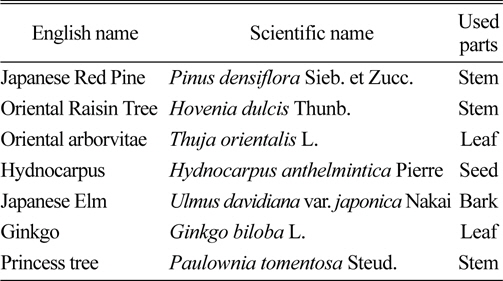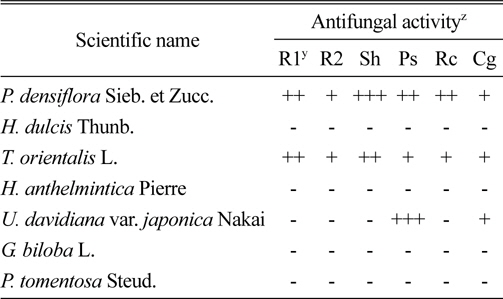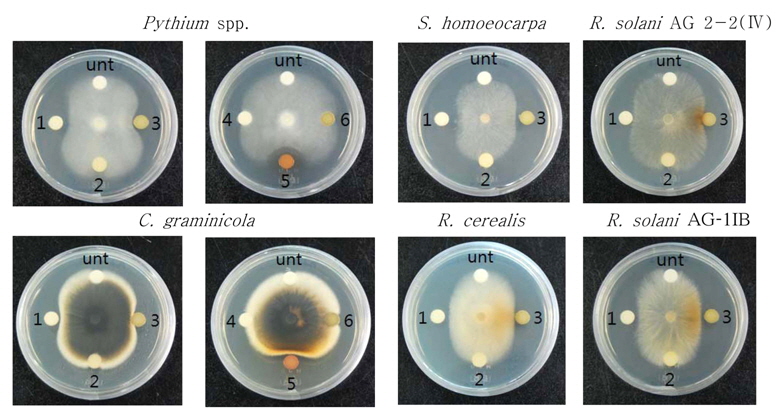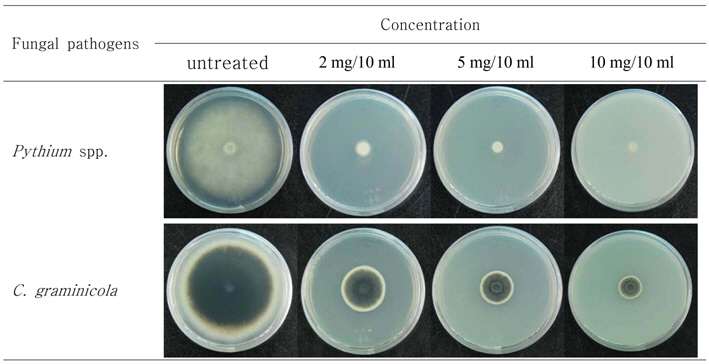



Seven medicinal plant extracts were tested for antifungal activities against six species of the major turfgrass pathogenic fungi (
잔디는 600속에 7,500종이 있으나, 이 중 약 30여종만이 실제 잔디로 이용되고 있고, 종의 발생기원지와 그와 유사한 기후조건 및 토양조건을 가진 지역에서 최적의 생육상태를 나타내는데, 발생기원지와 생육형에 의해 크게 한지형 잔디(cool-season grass)와 난지형 잔디(warm-season grass)로 분류된다(Ryu, 2007). 골프장에 조성된 잔디는 이용목적상 매우 섬세하게 관리되어야 하므로 빈번한 예초 및 토양갱신, 시비 등 집약적인 관리 작업이 실시되며, 연중 경기자에 의한 답압에 의하여 많은 상처를 받는 등 매우 부적절한 인공 환경 하에서 생육이 이루어지고 있다. 골프장에 조성된 잔디는 야생잔디에 비하여 병 저항성이 극히 저하되어 있으며, 이러한 잔디밭에서는 여러 가지 병해가 발생된다(Shim and Kim, 1995).
잔디에 발생되는 병은 약 64가지 정도이며, 병을 일으키는 병원균은 약 90여종으로 대부분 한지형 잔디에 발생되는 병으로 보고되어 있다(Couch, 1985). 또한 우리나라 공원이나, 스포츠필드 및 골프장에 식재되어 있는 잔디에 발생되는 병은 약 14종이며 병에 관여하는 병원균은 약 17종으로 알려져 있다(List of Plant Diseases in Korea, 2009). 이들 중 잔디에 주로 문제가 되는 병해로 난지형 잔디에는
잔디에 발생하는 각종 병을 예방 및 방제하기 위해서는 정기적으로 농약을 살포하게 되는데 이러한 경우 심각한 독성문제와 환경오염을 일으킬 뿐만 아니라, non target disease를 유발시키기도 한다(Lee, 1997). 이러한 문제점들을 경감시키고, 생태계 보전 및 환경 친화적인 기술개발을 위해 식물추출물, 길항미생물 등을 이용한 생물학적 방제 요소의 연구 개발이 이루어지고 있다. 특히 식물이 생산하는 다양한 allelochemical을 이용하기 위해 식물의 추출물을 사용한 해충 및 잡초 방제에 대한 연구들이 이미 오래전부터 여러 분야에서 연구되고 있으며, 작물에 발생하는 병의 병원균에 대한 효과도 보고되어 왔다(Chon et al., 2003; Kim and Lee, 2007; Lee et al., 2001, 2004). 이러한 연구들 중 측백나무, 참오동나무, 송절(소나무마디), 대풍자는
본 시험은 항균활성이 보고된 식물추출물을 이용하여 잔디 병해방제에 대한 효과를 검증하고, 친환경적인 잔디병해방제에 대한 실용성 평가와 이에 대한 기초자료를 얻기 위해 실시되었다.
실험에 사용한 약용식물은 송절(
[Table 1.] List of the medicinal plants used for antifungal activity test.

List of the medicinal plants used for antifungal activity test.
약용식물 7종의 메탄올 추출물 조제를 위해 약용식물 100 g당 500 ml의 메탄올을 가하여 80℃에서 4시간씩 3회 추출하였으며, 이후 추출액은 Filter paper (Whatman No.2)로 거른 후 감압 농축하였다. 농축액은 건조시킨 후 4℃에서 냉장 보관하며 사용하였다. 각각의 약용식물 추출물은 소량의 메탄올 또는 DMSO (dimethyl sulfoxide)에 녹인 후 적정 농도로 희석하여 항균활성 평가에 사용하였다.
실험에 사용된 잔디 병원균은 한국잔디연구소에서 분양받은 균을 4℃에 냉장보관하면서 주기적으로 계대배양 하여 사용하였다. 공시균주는 갈색퍼짐병을 유발하는
시험에 사용된 약용식물 추출물에 대한 항진균 활성 탐색을 위해 Paik et al. (1998)의 방법을 응용하여 고압 멸균한 PDA 배지를 Petri dish (87×15 mm)에 분주하여 평판배지를 만든 다음 완전히 굳히고, 추출물 1 mg당 10 μl의 메탄올로 희석하여 Paper disc (∅8 mm)에 50 μl씩 점적하였다. 메탄올이 완전히 휘발된 다음 PDA 평판배지 가장자리에 Paper disc를 치상하였다. 시험 균주는 Cork borer (5 mm)로 채취하여 배지 중앙에 치상하고, 25℃ 인큐베이터(Vision scientific, Korea)에서 각각의 시험균주가 다 자랄 때까지 배양하였다. 균이 다 자라면 clean zone의 형성유무를 확인하여 항균 활성 여부를 조사하고 약용식물 추출물을 선발하였다.
항진균 활성 탐색을 통해 선발된 약용식물 추출물에 대하여 디스크 확산법으로 항진균 활성 검정을 실시하였다. 균사생육 억제효과 검정에 사용된 배지의 제조는 PDA 배지를 고압 멸균하여 약 50℃까지 냉각시킨 뒤 DMSO 10 μl당 추출물 1 mg의 희석비율로 stock solution을 만든 다음 약용식물 추출물을 배지 10 ml 당 2 mg(5000배), 5 mg(2000배), 10 mg(1000배)이 첨가 되도록 stock solution을 주입하여 혼합하고, Petri dish (87×15 mm)에 분주하여 굳혔다. 시험균주는 Cork borer (5 mm)로 채취하여 각각의 추출물 별로 3반복으로 시험 배지 중앙에 치상한 다음 25℃ 인큐베이터에서 배양하였다. 추출물을 첨가하지 않은 무처리 배지에서 병원균이 다 자라면 첨가 배지와 무첨가 배지의 병원균의 균총 지름을 측정하여 무처리 대비 균사생육 억제율(%)을 구하였다.
균사생육 억제율(%) = 100−{(추출물 첨가 배지에서 병원균 균총의 평균지름/무첨가 배지에서 병원균 균총의 평균지름)×100}
각각의 잔디병원균 균주에 대한 약용식물 추출물의 균사생육 억제율(%)은 무처리구 균주의 균총 지름과 추출물 처리구 균주의 균총 지름을 측정하여 균사생육 억제정도를 조사한 다음 통계 분석하였다. 모든 데이터는 SAS (Statistical Analysis System: program, SAS Institute Inc., 2003) 프로그램을 활용하였으며 평균간 비교는 유의수준 5% 수준에서 던칸의 다중분석을 사용하였다.
총 7가지의 약용식물 추출물을 사용하여 잔디 병원균 6종에 대해 디스크 확산법을 실시하여 항균 활성도를 측정하였다. 약간의 차이는 있었지만 송절은 6종의 잔디 병원균 모두에 항균활성이 있는 것으로 나타났으며 그 중

Antifungal activities of the medicinal plant extracts to several fungal pathogens by paper disc method.
위의 실험 결과에서 송절, 측백 추출물은 잔디 병원균 6종에 대해 항균활성을 나타내었으며, 유백피 추출물은
앞서 디스크 확산법에서 항진균 활성을 나타낸 3종의 약용식물 추출물을 사용하여 균사생육 억제효과 검정을 실시하였다.

Suppression of mycelium growth of several fungal pathogens on the medium supplement with medicinal plant extract.
항균활성이 보고된 약용식물의 추출물을 사용하여 실험을 진행한 결과 총 7가지의 추출물 중 3가지의 추출물에서 항진균활성이 있는 것으로 나타났으며, 균사생육 억제효과 검정에서 송절 추출물 1,000배액 처리로
환경부의 2011년도 통계에 따르면 전국 골프장은 421개소로 2010년에 비해 25개 증가하였고, 단위면적당 평균사용량은 감소하였으나 연간 400톤(실물량)의 농약을 사용하는 것으로 나타나 앞으로 골프장에서 농약 사용량을 줄여나가기 위해서는 더욱 많은 친환경 방제 방안이 필요한 실정이다(https://sgis.nier.go.kr). 또한




